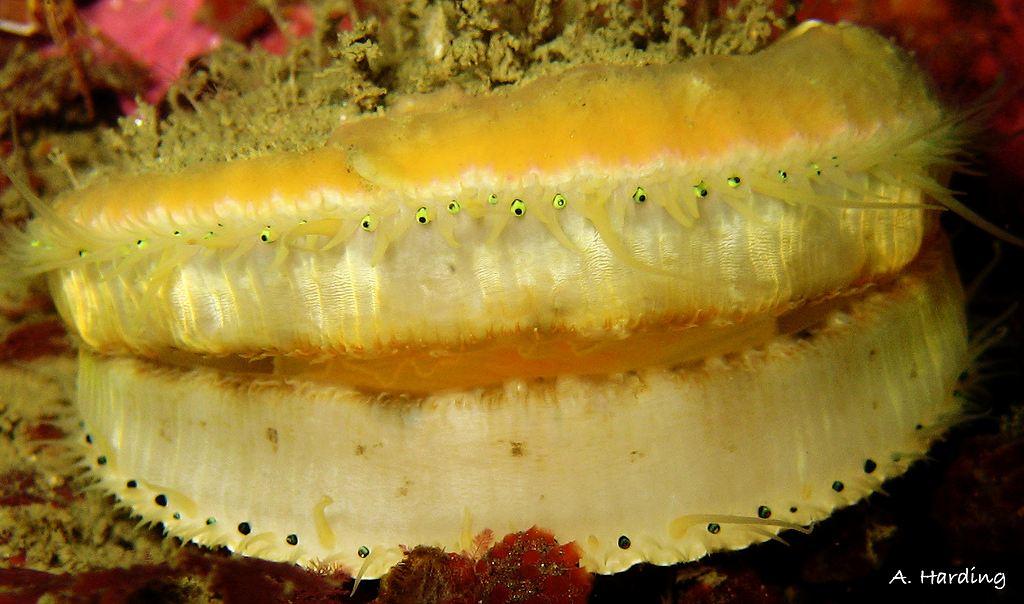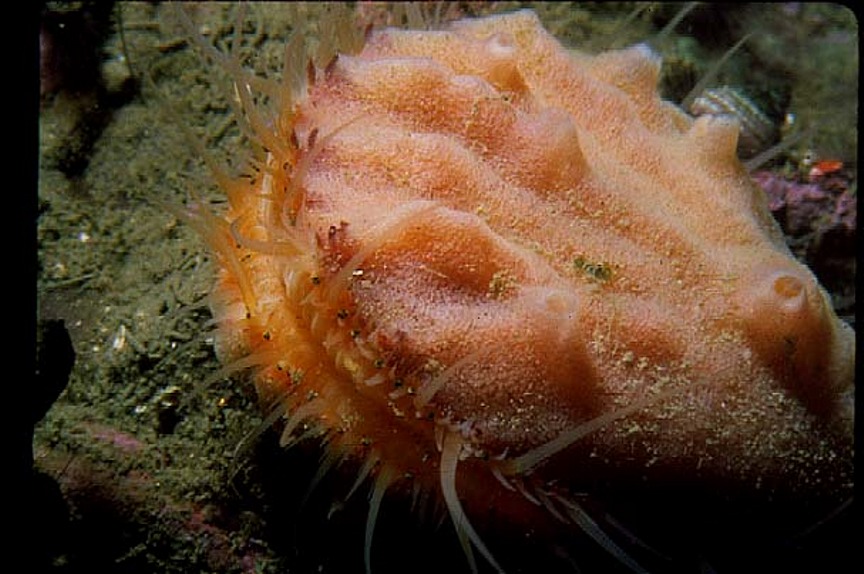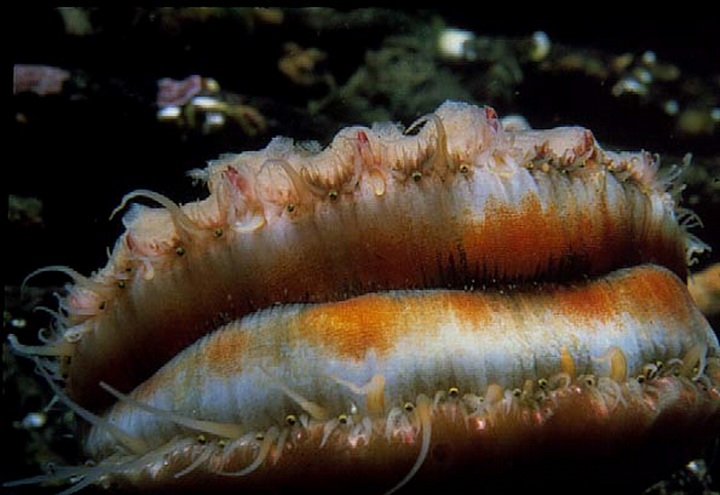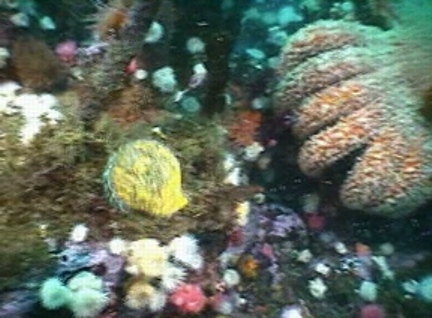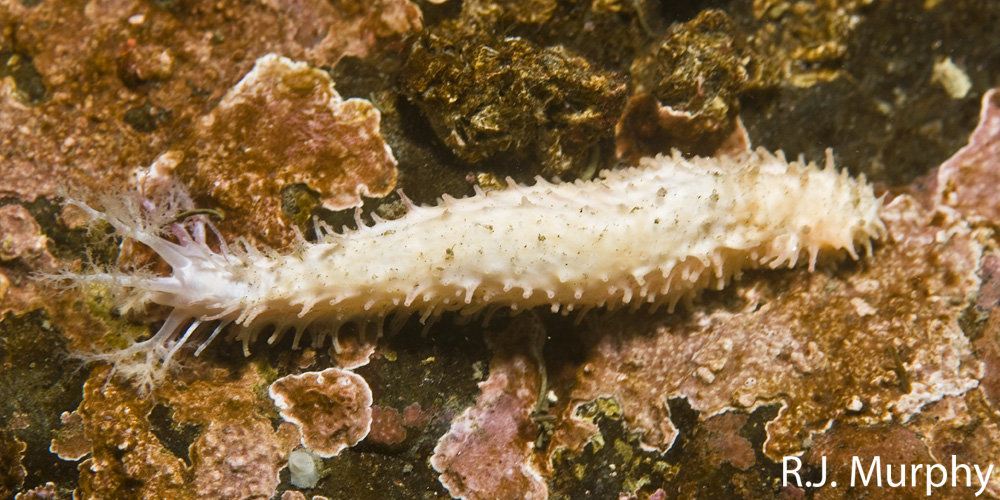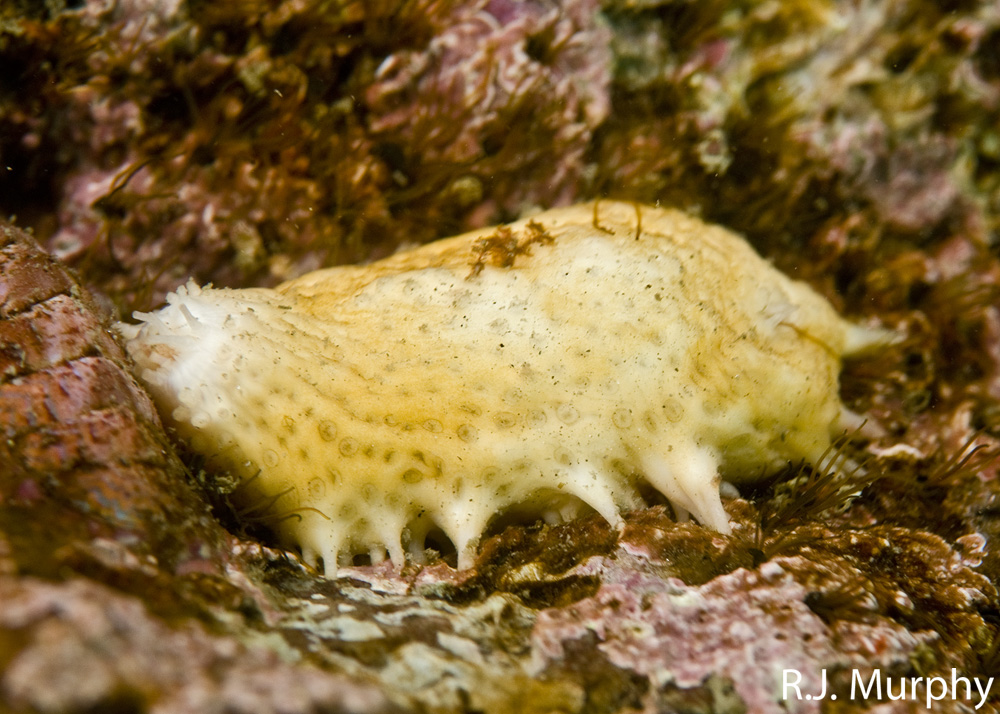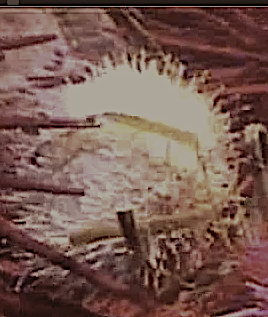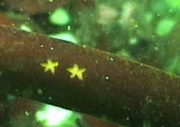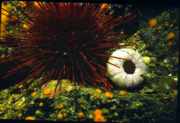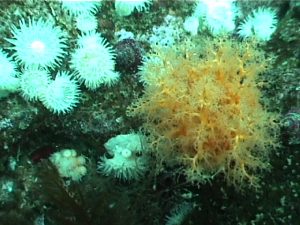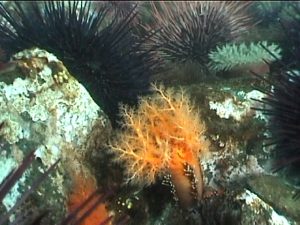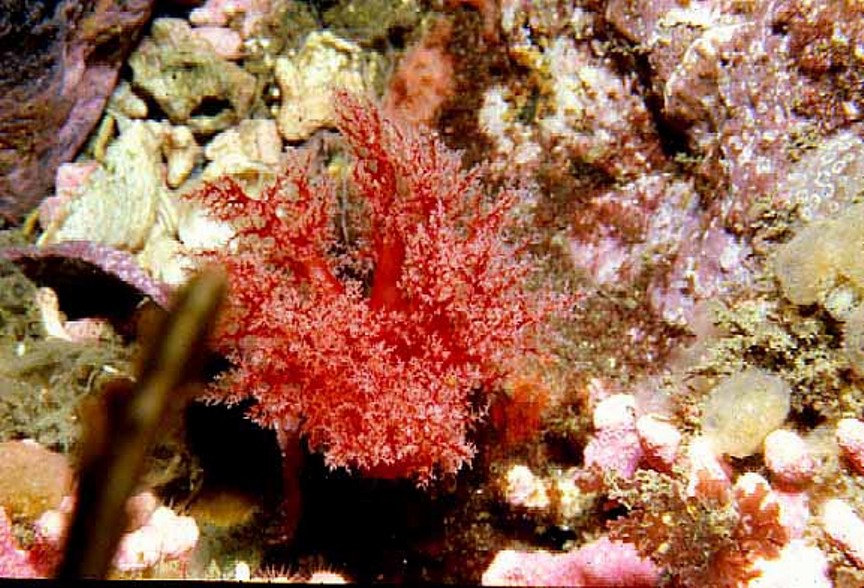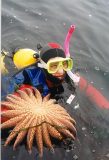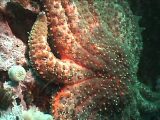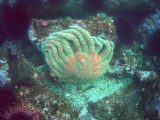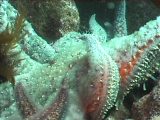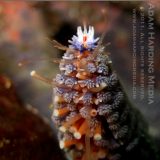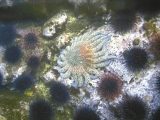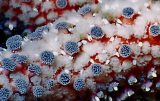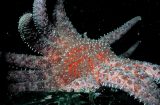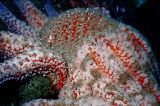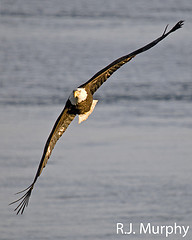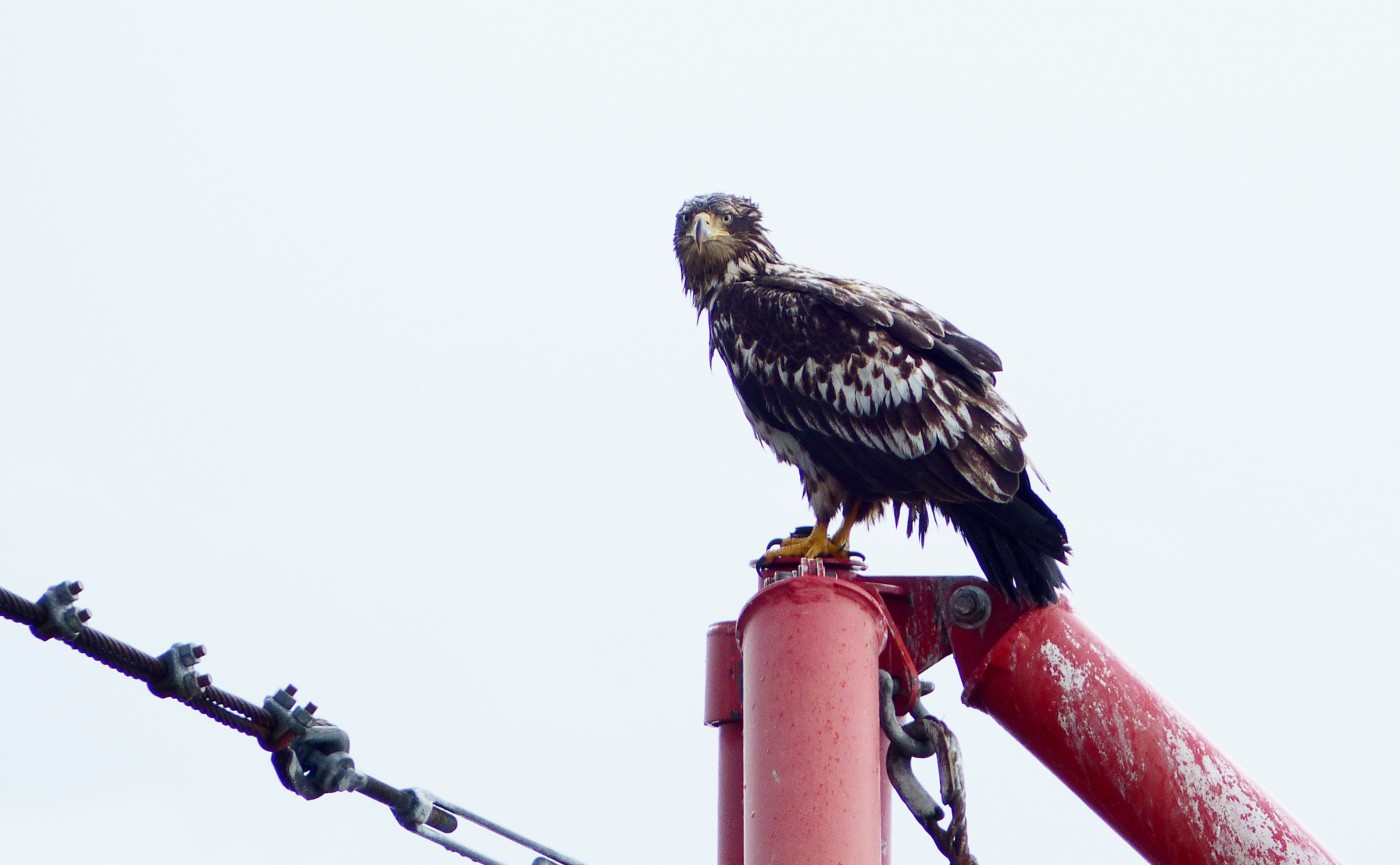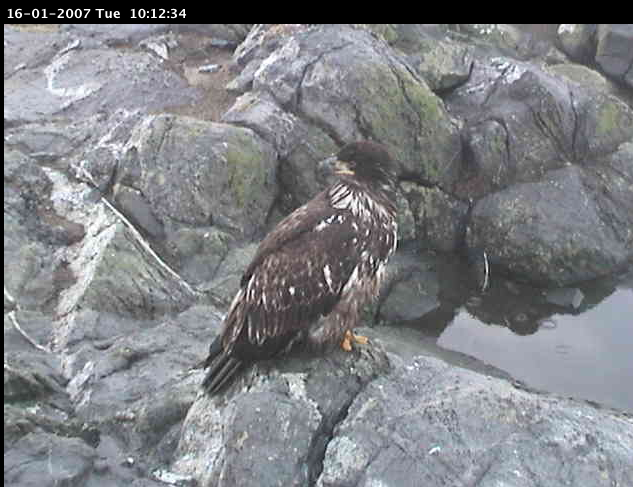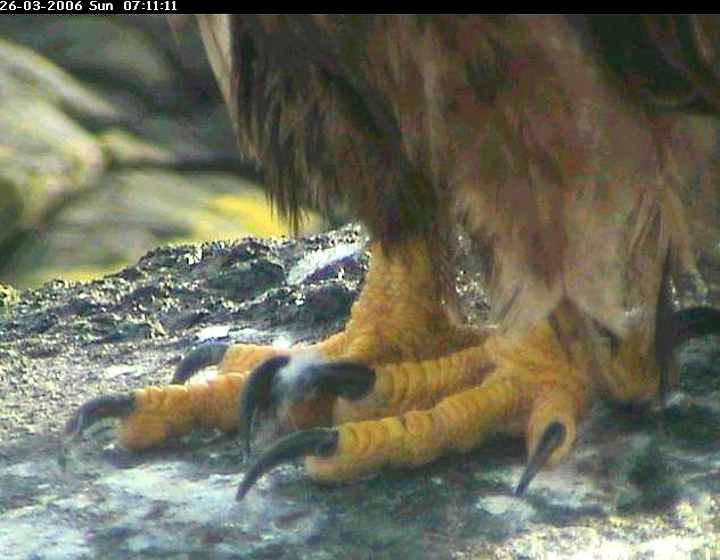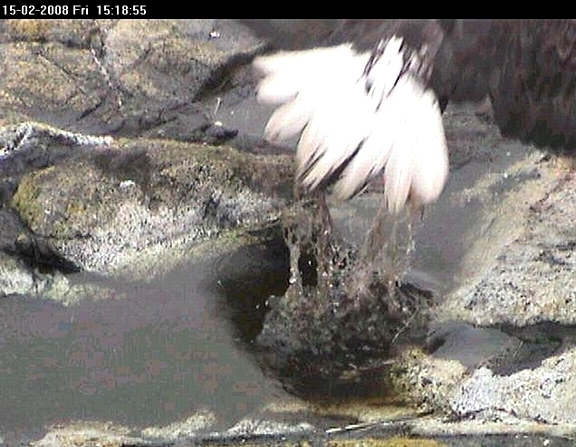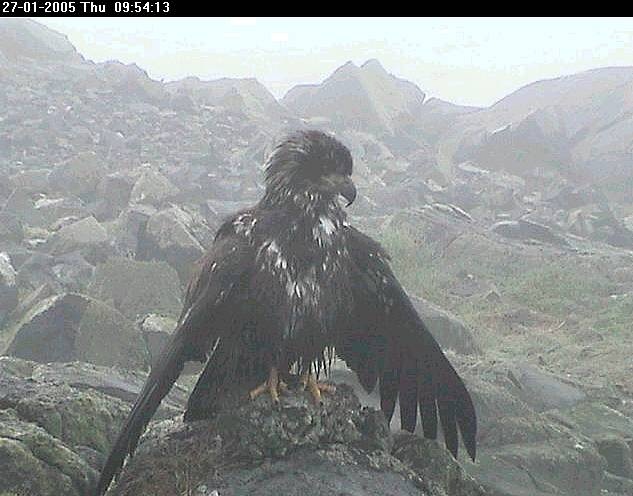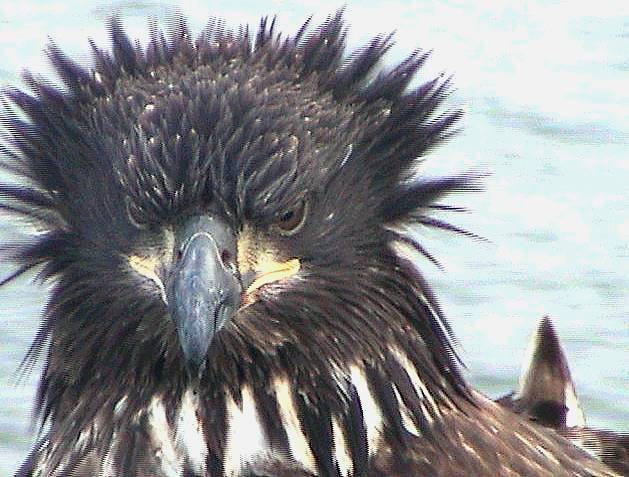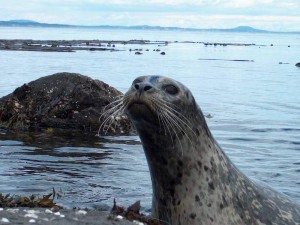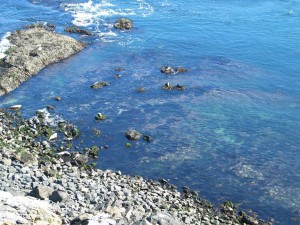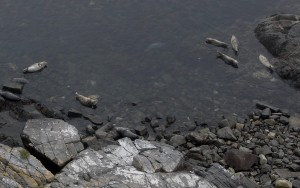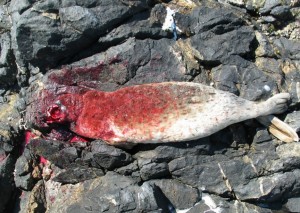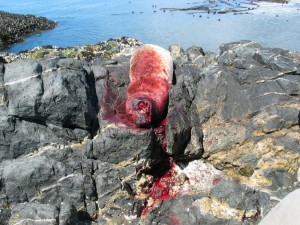In April of each year we begin to get tides that are low enough for intertidal research. This video starts with students measuring temperature and salinity in tidepool #4 , then collecting “harpacticoids ” in tidepool #10, then doing further measurements in the new artificial pool #13. The wind was blowing at West 25 kn., but it didn’t deter our class!
Category Archives: Video
Chlamys hastata: Swimming scallop
- A swimming scallop with a pink encrusting sponge.
- The mouth of the scallop. Note the blue eye-spots around the margins.
- The swimming scallop from the video above.
The swimming scallop is closely related to clams, oysters and cockles. Unlike some of its relatives, the swimming scallop is not sessile. The ribs of the swimming scallop are rendered rasplike by the presence of curved spines. The shell can grow up to 5 – 6 cm in height. They have beautiful, green iridescent and almost luminous eyes called ocelli that are found around the edge of the mantle in both valves. The ocelli are sensitive to light intensity and are rather complicated but do not form images. They also have sensitive tentacles that project out of the edge of the mantle.
They are usually found in subtidal areas and sometimes in shallow water. They live at depths ranging from 2 – 150 m.
Swimming scallops normally lie with their right valves against the substratum, and they may be attached periodically when they are younger by means of a byssus, a fine elastic fibre as in that secreted by mussels. Scallops are free spawning organisms. Reproduction is done through the release of sperm by males and eggs by females into the water.
Swimming scallops are filter feeders. They feed with the shell agape as it the picture above.They process water, using their ctenidia (or gills) to collect microscopic food and Oxygen from the water.
Sometimes spontaneously, and just about always when menaced by a predator, such as certain sea stars (Pisaster and Pycnopodia). They swim by a sort of jet propulsion, clapping the valves together and forcing water out through openings on both sides of the hinge. This shows in the video when the Pycnopodia is brought close to the scallop. The scallop senses the pycnopodia by a chemical sensor. The swimming scallop also swims away when there is a change in environmental conditions.
Swimming scallops are usually colonized by sponges, mostly on the left valve, that form thick coatings. The sponges provide camouflage for the scallop as well as defense against predators. The sponge’s porous nature hinders potential predators, such as sea stars from getting a good grip on the scallop, and they may also provide a repulsive chemical odor. This shows biological mutualism, where both organisms benefit in the symbiosis.
References:
Kozloff, E. N. Seashore Life of the Northern Pacific Coast .4th Edition (1996). University of Washington Press. 539 pages.
Kozloff, E. N. Marine Invertebrates of the Pacific Northwest. (1996). University of Washington Press. 370 pages.
Domain Eukarya
Kingdom Animalia
Phylum Mollusca
Class Bivalvia
Order Ostreoida
Sub Order Pectinina
Family Pectinidae
Genus Chlamys
Species hastata
Common Name: Swimming Scallop
Other Members of the Phylum Mollusca at Race Rocks.
and Image File |
 The Race Rocks taxonomy is a collaborative venture originally started with the Biology and Environmental Systems students of Lester Pearson College UWC. It now also has contributions added by Faculty, Staff, Volunteers and Observers on the remote control webcams. The Race Rocks taxonomy is a collaborative venture originally started with the Biology and Environmental Systems students of Lester Pearson College UWC. It now also has contributions added by Faculty, Staff, Volunteers and Observers on the remote control webcams.
Victoriano de Jesus PC year 28 |
Eupentacta quinquesemita:white sea cucumber–The Race Rocks Taxonomy
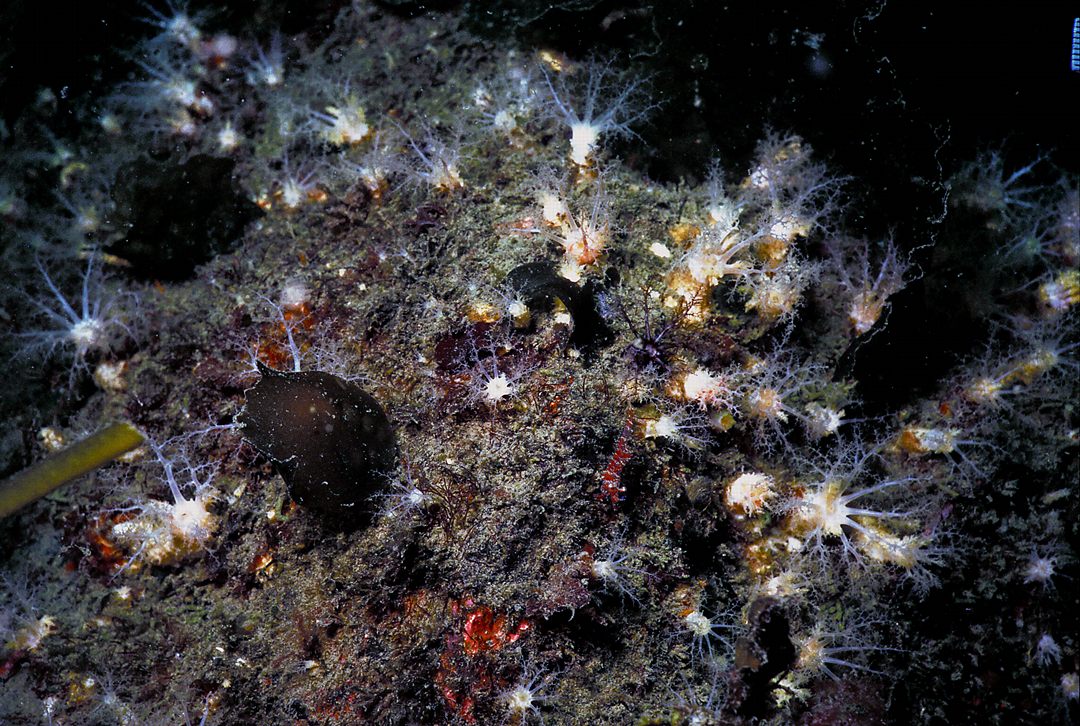 Here are the tentacles extended on a cluster of Eupentaca.Their bodies are hidden. Photo by Dr.A. Svoboda
Here are the tentacles extended on a cluster of Eupentaca.Their bodies are hidden. Photo by Dr.A. Svoboda
GENERAL DESCRIPTION
Eupentacta quinquesemita is stiff to touch due to abundant calcareous ossicles in the skin and tube feet. The body grows 4-8 cm in length. The non-retractile tube feet give it a spiky look. It has five rows of tube feet (four tube feet in width) with smooth skin between. The two ventral feeding tentacles are smaller than the other eight. This character is useful for identifying this species when only the tentacles are visible. The expanded tentacles are creamy white with tinges of yellow or pink at the bases.
Skin ossicles: numerous large, porous, ovoid bodies dominate the ossicles but among them are small, delicate baskets. The latter are important in differentiating this species from Eupentacta pseudoquinquesemita.
HABITAT
They are fairly common under the rocks and in cervices, low intertidal zone on rocky shores; common on concrete piles and marina floats in Monterey harbor, Vancouver (British Columbia) to Morro Bay (San Luis Obispo. Co). High densities of this species occur in strong currents. Juveniles (up to 1 cm) settle among hydroids and small algae in high current areas and on floating docks.
REPRODUCTION
Eupentacta quinquesemita is a suspension feeder. It spawns from late March to mid May. The female produces eggs greenish in color, 370 to 416 um diameter: the male releases sperm, and fertilization takes place in open water. The yolky egg develops into a non-feeding evenly ciliated larva. In culture, the larva grows to the armoured stage in 11 to 16.5 days.
PREDATORS
The predators of Eupentacta quinquesemita are: the Sun Star (Solaster stimpsoni), the Sunflower Star (Pycnopodia helianthoides), the Six-armed Star (Leptasterias hexactis) and the Kelp Greenling (Hexagrammos decagrammus).
BIOTIC ASOCIATION
The internal parasite, Thyonicola americana, a shell-less wormlike snail, attaches elongated coils of eggs to the intestine of E. quinquesemita. The larvae are released into the intestine and probably scape through the anus. Any parasites that are ejected by evisceration perish.
FEEDING
Is by shovelling of sediment into the mouth and digesting the microfauna within. No direct feeding is required. Is omnivore.
DomainEukarya
Kingdom Animalia
Phylum Echinodermata
Class Holothuroidea
SubclassDendrochirotacea
Order Dendrochirotida
Family Sclerodactylidae
Genus Eupentacta
Species quinquesemita
Common name White sea cucumber
REFERENCES
Lambert, P. 1997. Sea Cucumbers of British Columbia, Southeast Alaska and Puget Sound. UBC Press, British Columbia Canada. 166 pages
Morris, R., P. Abbott, and E. Haderlie.1980. Intertidal Invertebrates of California. Standford University Press, Stanford, California. 690 pages.
Kozloff, E. 1996 . Seashore Life of the Northern Pacific Coast. Fourth Edition. University Of Washington Press. Seattle and London. 370 pages.
| Other Members of the Phylum Echinodermata at Race Rocks |
and Image File |
 The Race Rocks taxonomy is a collaborative venture originally started with the Biology and Environmental Systems students of Lester Pearson College UWC. It now also has contributions added by Faculty, Staff, Volunteers and Observers on the remote control webcams. The Race Rocks taxonomy is a collaborative venture originally started with the Biology and Environmental Systems students of Lester Pearson College UWC. It now also has contributions added by Faculty, Staff, Volunteers and Observers on the remote control webcams.
Patricia (PC year28) |
Strongylocentrotus droebachiensis: Green sea urchin –The Race Rocks taxonomy
Green Sea Urchin: average size is 50-60 mm, but may reach a maximum size of about 85 mm.
Distribution: The green sea urchin is one of the most widely distributed of all Echinoderms. It has a circumpolar distribution, which extends into the Arctic regions of both the Atlantic and Pacific Oceans. It commonly inhabits the rocky subtidal zone from the low-tide mark down to a depth of 1200 m, but also occurs intertidally in tide pools.
Diet: The green sea urchin primarily grazes on seaweeds (kelp being its preferred food source), but will also consume a wide variety of organisms including mussels, sand dollars, barnacles, whelks, periwinkles, sponges, bryozoans, dead fish, and – when hungry enough – other sea urchins.
This shows the grazing action of sea urchin teeth, arranged in a complex assemblage of small bones, the five teeth gouged out this star pattern in the stipe of a Pterygophora.
The skeleton of the sea urchin is called a “.test”. The radial symmetry is reflected in the placement of all the tube feet holes. Here you can see the size of a green urchin compared to a red urchin
Reproduction: Green sea urchins release their gametes into the water column where the eggs are fertilized by the sperm. The sexes are separate. The resulting larva (termed an “echinopluteus”) undergoes development planktonically for a period of one to several months before settling on the sea floor and metamorphosing into the adult form. Reproduction occurs on an annual cycle with spawning occurring in the spring, generally between February and May, but sometimes as late as June. See the Lab on Sea urchin Embryology.
This video from underwater Safari shows a wolf eel crunching a sea urchin…
Behavior: Where urchins occur at high density, destructive grazing can produce habitats devoid of seaweeds. These areas may be termed “sea urchin barren grounds”.. When sea urchins are removed from these sites, either manually or by disease, the reduction in grazing pressure often results in the development of highly productive kelp forests. These kelp beds provide shelter for a wide variety of marine organisms (e.g. fish, lobsters, crabs, sea stars, bivalves, gastropods, bryozoans) and the habitat is typically much more diverse than barren grounds. Hence, sea urchins are one of the principal factors controlling habitat diversity in the rocky subtidal environment.
| Other Members of the Phylum Echinodermata at Race Rocks |
and Image File |
 The Race Rocks taxonomy is a collaborative venture originally started with the Biology and Environmental Systems students of Lester Pearson College UWC. It now also has contributions added by Faculty, Staff, Volunteers and Observers on the remote control webcams. The Race Rocks taxonomy is a collaborative venture originally started with the Biology and Environmental Systems students of Lester Pearson College UWC. It now also has contributions added by Faculty, Staff, Volunteers and Observers on the remote control webcams.
Aldo Caixeta (PC yr 28)/strong> |
Cucumaria miniata: Orange sea cucumber–The Race Rocks Taxonomy
The orange Cucumaria miniata sea cucumber is a common resident just off the docks at Race Rocks in 5 to 10 meters of water. In this video they occur in a high concentration relative to other areas. Each orange tuft is the tentacle mass. If disturbed, it quickly withdraws into the sea cucumber body which is always buried under loose rocks.
Note the name Cucumaria miniata should be on the following video instead of C. curata
| General Description:The Orange sea cucumber received its Latin name, Cucumaria because it resembles a cucumber. The orange pigment that separates it from other sea cucumbers comes from a chemical called cinnabar or vermilion. Although it seems to be completely soft and fragile, it actually has bone-like plates in the body wall called ossicles. To stay attached to the holes between the rocks, the cucumber uses tube feet that you can see in the image above in 5 rows around the circumference of the body. If you ever want to keep one as a pet, don’t get too attached because they usually only live about 5 years, sometimes 10 if they’re lucky.
Habitat: Sea cucumbers live in between boulders and sheltered rock formations. Because they are able to stay attached to surfaces, they prefer to live in areas with stronger currents, making it harder for predators to reach them. Feeding: The orange sea cucumber is a suspension feeder. This means that it catches food in its tentacles. After the food is caught, it removes the food with its eating arms and scrapes it into its mouth. Sea cucumbers eat plankton and detritus. Reproduction: Unfortunately, sea cucumbers aren’t very intimate creatures. In fact, their mating process can’t have any less contact. When the time comes to make a new cucumber and two cucumbers are physically (and emotionally) ready, one will release eggs into the water and the other will release sperm. From that, the two elements meet in suspension and that’s it. Predators and Defenses: The cucumbers main predators include fish, and even humans. That’s right kids, there are some people in the world that actually eat these things. To protect itself, the cucumber has many defenses. Their skin is some of the most amazing tissue found on an animal. The compound is made of a material called ‘catch collagen’ which can change from liquid to solid when neurologically triggered. It does this so can squeeze into small spaces and then harden again. Another defense is they “pee” out all the water in their system and shrink into a small, hard rock. The “peeing” usually occurs when the cucumber is removed from its habitat. If that’s not enough for you, they also can bust out a defense called evisceration. What happens here is if the cucumber is stressed and scared enough, it will spew its guts out. That means everything, intestines, gonads, respiratory organs, everything. Now after that, you would think that’s the end but if it can get itself to a safe habitat, it can actually regenerate its organs. Biotic Associations These guys are generally really passive, and they don’t really interact with any other organism or with between each other really. |
|||||||||
| References:http://oz.plymouth.edu/~lts/invertebrates/Primer/text/holothuroidea.html
http://www.afsc.noaa.gov/hodiak/photo/cuke03.html |
|||||||||
Domain Eukarya
Kingdom Animalia
Phylum Echinodermata
Class Holothuroidea
Family Cucumariidae
Genus Cucumaria
Species miniata
Common Name: Orange Sea Cucumber
| Other Members of the Phylum Arthropoda at Race Rocks |
and Image File |
 The Race Rocks taxonomy is a collaborative venture originally started with the Biology and Environmental Systems students of Lester Pearson College UWC. It now also has contributions added by Faculty, Staff, Volunteers and Observers on the remote control webcams. The Race Rocks taxonomy is a collaborative venture originally started with the Biology and Environmental Systems students of Lester Pearson College UWC. It now also has contributions added by Faculty, Staff, Volunteers and Observers on the remote control webcams.
March OctoberFebruary , 2002, Andres Jennings (PC yr 28) |
Psolus chitonoides: creeping pedal sea cucumber
Predation of a Psolus chitinoides by a sea star is examined and discussed by Laura and Nadege. The stomach of the sea star surrounds the sea cucumber and the soft neck and mouth of Psolus is well inside the cavity of the sea
Sea cucumbers have inhabited the world’ s oceans for about 400 million years. Psolus chitonoides is an unusual species of these marine invertebrates. Its diverse characteristics have given it 4 common names: Armoured sea cucumber, Creeping armoured sea cucumber, Slipper sea cucumber and Creeping pedal sea cucumber.
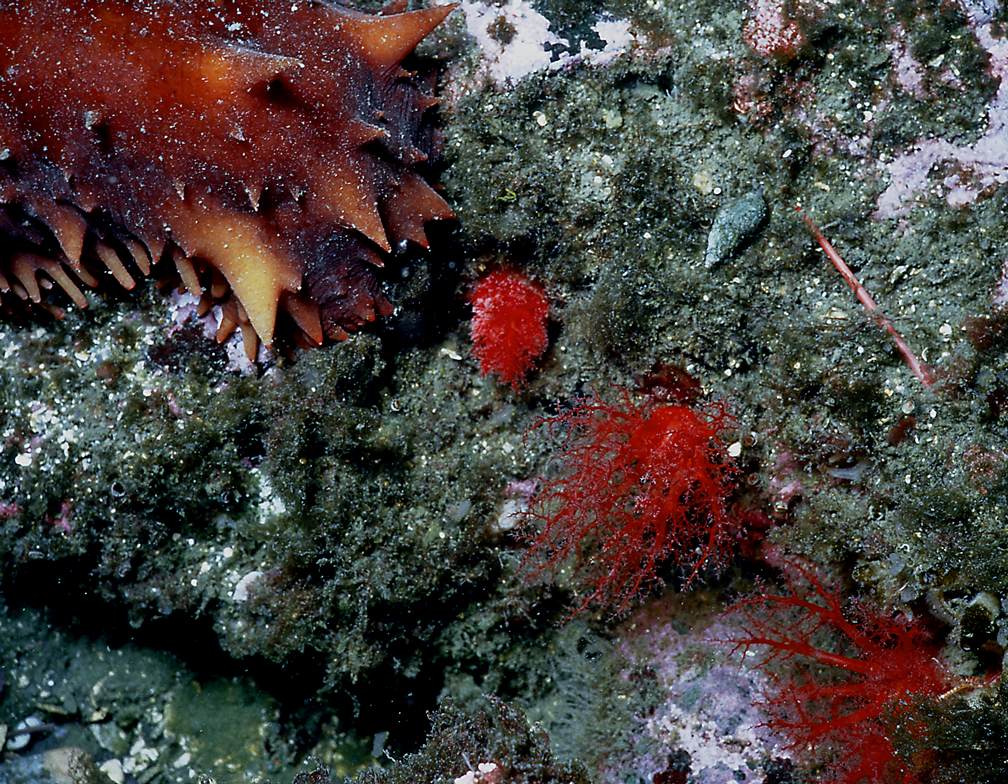
Compare the tentaclesof Psolus with the end of the California Sea Cucumber to the left. Photo by Dr.A.Svoboda
A-Description
As all echinoderms, the creeping pedal cucumber has a spiny skin. Also, its appearance is closer to a chiton than to a sea cucumber (here is the origin of its name “chitonoides“).
1-External features:an oval body (7cm long to 5.8 cm wide) domed dorsally with stiff, shingle-like scales, flat, flexible sole ventrally. Its tentacles(8-10) are dendritic, equal in size, or 8 large and 2 small. Also observing the body, it could be compared to an elongate cylinder lying on its side with the mouth at one end and the anus at the other. The rows of tube feet run the length of the body
2-Internal features: the tentacle ampullae, the rete mirable and cuverian organs are absent . On the other hand, we can observe the presence of retractor muscles. Respiratory trees are “y shaped”. Note that its madreporic body is attached to a dorsal mesentery. Its internal calcareous skeleton is composed as following:calcareous ring with anterior processes only. Psolus chitonoides is characterized by typical skin ossicles, where one type of circular perforated plate (some with knobs coalesced into a raised network) occur only in the ventral sole.
Domain Eukarya
Kingdom Animalia
Phylum Echinodermata
Class Holothuroidea
SubclassAspidochirotacea
Order Dendrochirotida
Family Psolidae
Genus Psolus
Species chitonoides
Common Name: Creeping pedal sea cucumber
B-Physiology and Biology
1-Suspension feeder: tentacles trap larger particles (larger than 2mm) by bending inwards to form a cagelike enclosure. The mouth lips extend toward the particle as the nearest tentacle pushes it into the mouth .
2-Reproduction : the reproductive organs of a sea cucumber generally consist of 1 or 2 tufts of elongated tubules in the forepart of the body cavity.Spawning occurs annually, from mid March ot late May, commonly in the early morning. A spawning male will swab its genital papilla with its tentacles, then lift the tentacles to disperse the sperm . Females release long ropes of brick red eggs; fertilized eggs develop into pelagic lecithotrophic vitellaria larvae. Late larvae and early juveniles are negatively phototatic and settle gregariously.
3- Respiratory system: its water vascular system is a hydraulic system made up of tubes and valves that operate rows of extendible tube feet . As other sea cucumbers, Slipper sea cucumbers respire through their tube feet, body wall and respiratory trees.
4-Chemicals: there are toxic chemicals (saponins) on its tentacles, discouraging predators from nipping the tentacles. For example, even the Kelp Greenling (Hexagrammos decagrammus), which feeds on sea cucumbers, avoids this species.
C-Predators, parasites and commensals
1-Sea stars and fish are the main predators of the Psolus chitonoides.
2-Parasitic forms of flatworms and snails can live inside the sea cucumber
3-Commensal organisms are mostly scales that mimic the colour of sea cucumbers, and crawl on their skin.
D-Habitat
From exposed coast to sheltered inlets; although it seems to prefer clean, vertical rock that is free of sediment. Its soft, flat sole enables it to attach firmly to rock.
E-Range
Aleutian Islands to Baja California ; intertidal to 247m ; common in shallow subtidal areas.
References:
Kozloff, E.N. Keys to the Marine Invertebrates of Puget Sound , the San Juan Archipelago, and Adjacent Regions.
Lambert, P. 1997. Sea cucumbers of British Columbia, Southeast Alaska, and Puget Sound. UBC Press,
| Other Members of the Phylum Echinodermata at Race Rocks |
and Image File |
 The Race Rocks taxonomy is a collaborative venture originally started with the Biology and Environmental Systems students of Lester Pearson College UWC. It now also has contributions added by Faculty, Staff, Volunteers and Observers on the remote control webcams. The Race Rocks taxonomy is a collaborative venture originally started with the Biology and Environmental Systems students of Lester Pearson College UWC. It now also has contributions added by Faculty, Staff, Volunteers and Observers on the remote control webcams.
March October 2003- Rahilla (PC) |
Pycnopodia helianthoides: Sunflower star–The Race Rocks taxonomy
- Loreen Pindera displays the oral side of the pycnopodia to shore-bound visitors.
- The dorsal side , with grey tufts where the gills are loated. White pincers on the dorsal side are the pedicellaria
- Photos by Pearson College Divers.
- The tube feet of the Pycnopodia
- Adam Harding took this picture of the red eye spot at the end of a tentacle.
- forcep-like structures used to defend the surface. A good habitat image of bith Pycnopodia and the giant red urchin.
- Close up of pedicellaria, tiny forcep-like structures used to defend the surface.
- Pycnopodia : These three last photos are derived from photos by Dr.A.Svoboda
- Dorsal surface showing gills
Pycnopodia tend to be found thriving in regions rich in seaweed, in low intertidal zones on rocky shores. They have an arm radius that ranges from forty to sixty-five centimeters. Small juveniles have five arms but develop twenty four by the time they are adults. Pycnopodia have an aboral surface and are usually pink, purple or brown in color. Occasionally they will be red or yellow in color. They also have the ability to regenerate lost arms. Pycnopodia are the largest, heaviest and most active of the Pacific coast sea stars. Pycnopodia feed on Stronglyocentrotus purpuratus (the purple sea urchin), bivalves, polychaetes, chitons, snails, hermit crabs, crabs, sea cucumber, and Leptasterias sea stars . The Pycnopodia utilize over fifteen thousand sucker feet when capturing prey. Their prey is swallowed whole and digested internally, and they have the ability to partially evert their stomach. Antagonistic, combative behavior has been observed when two Pycnopodia encounter one another. The key predator of the Pycnopodia is the King Crab. A fourfold increase in speed has been noted when the Pycnopodia is in contact with a predator. If the Pycnopodia does not escape, the predator will latch on to one of its many arms and begin to feed.
The sea star Pycnopodia helianthoides is one of the largest invertebrate predators at Race Rocks. In this close up view, on the dorsal side, the pinkish tufts contain the pedicellariae (small pincers) and the dermal branchiae (for gas exchange) On the ventral view, the central mouth is surrounded by many tube feet.
In October, 2001, federal Fisheries Minister Herb Dahliwal and the Provincial Environment Minister Joan Sawiki visited Race Rocks to officially proclaim the opening of the Race Rocks MPA. In this video, Ryan Murphy shows the ministers a Pycnopodia.
Domain Eukarya
Kingdom Animalia
Phylum Echinodermata
Class Asteroidea
Order Forcipulatida
Family Asteriidae
Genus Pycnopodia
Species helianthoides
common nameSunflower Star
References cited:
Marine Invertebrates of the Pacific Northwest, Eugene N Kozloff, 1996, University of Washington Press
Intertidal Invertebrates of California, Robert H Morris Donald P Abbot and Eugene C Haderlie, 1980, Stanford University Press
Pacific Seashores- A Guide to Intertidal Ecology, Thomas Carefoot, 1977, J.J. Douglas Ltd
| Other Members of the Phylum Echinodermata at Race Rocks |
and Image File |
 The Race Rocks taxonomy is a collaborative venture originally started with the Biology and Environmental Systems students of Lester Pearson College UWC. It now also has contributions added by Faculty, Staff, Volunteers and Observers on the remote control webcams. The Race Rocks taxonomy is a collaborative venture originally started with the Biology and Environmental Systems students of Lester Pearson College UWC. It now also has contributions added by Faculty, Staff, Volunteers and Observers on the remote control webcams.
December 2001- Hannah McKinnnon (PC) |
Male Elephant seal Vocalization
Normally in past years, during the winter and summer, the 2 male elephant seals have stayed around the middle island. This year, this one large male hauled out onto the rocks to the south of the tower for a few days. In this video, note the clicking sound that he emits when his head is in the air. Thanks to Chris Blondeau and Jane Johnston for getting the footage for this unique piece of video late one evening in late December, when they were out relieving for Mike and Carol at the MPA.
Haliacetus leucocephalus: Bald Eagle–The Race Rocks Taxonomy
- Click to enlarge. Photo by Pam Birley on remote cam 5
In November 2009, Ryan Murphy captured this set of images when a juvenile eagle was making his daily pass by to prey on a seabird. The juvenile california gull provides the meal for that day. Click the image to see a slide show video of this sequence..See the Eagle Set on Ryan’s Flickr site
Bald Eagles measure from 30″ to 43″ ( 76 to 109 cm) in length and from 70″ to 96″ ( 2 to 2.4 m) in wingspan. They have a high thin, chittering voice which contrasts with its magnificent appearance. Bald Eagle’s diet is primarily based on fish catching. It also eats carrion and crippled waterfowl. At Race Rocks, eagles frequently take adult Gulls and Pigeon Guillemots as can be seen in the accompanying images.
The adult Bald Eagle has a snow-white head and tail, the immature ones have brown head feathers which develop white underneath and gradually grow out over several years.
It was formerly found living all over North America. Hunting, poaching and the growth of civilization has had a negative impact in the Bald Eagle population whch has dimished considerably in the last decades. Nowadays it is found only in the Aleutians, Alaska, sections of Northern and Eastern Canada, British Columbia, Northern United States and Florida.
Its habitat is on or near seacoasts as well as close to large lakes and rivers, where the fish population is abundant. It nests in tall conifers, often old growth Douglas Fir or Cedar. Nests are common in the Southern part of Vancouver island. The closest to Race Rocks are on Bentinck Island and along Taylor Beach. The nests are renovated every year starting in January with new sticks, often ripped from tall dead fir trees. The eggs are white and come in groups of 1 to 3 each time.Its beachcombing , scavenging role, and the fact that it eats at the highest trophic level, can cause the Bald Eagle to accumulate pesticides in its body ( from contaminated fish and wildllife. ) The Bald Eagle population remains high in the rain forest coastal area of central and Northern British Columbia and Alaska.
This image comes from the slide show “Fresh Kill” It provides a closeup of an eagle whose head coloring is almost mature, but has not yet lost its dark speckling.
Reference: Miklos D. F. Uduvardy ,1977 The Audubon Society, Field Guide to North American Birds, Western region., Chanticler press, fifth edition: NY
- Eagles on North Rock, GF photo
- wet juvenile
- Looking backward
- Pam Birley captured many of these images on the remote control camera
- Talons
- Tail
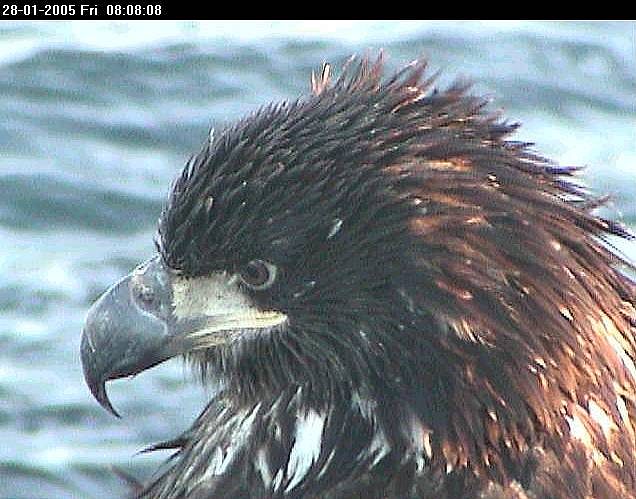 |
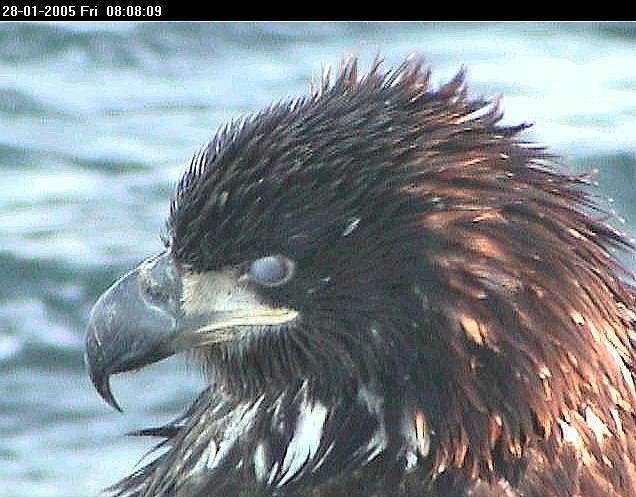 |
The nictitation membrane is a transparent inner eyelid in birds, reptiles, and some mammals that closes to protect and moisten the eye. It is also called the third eyelid. |
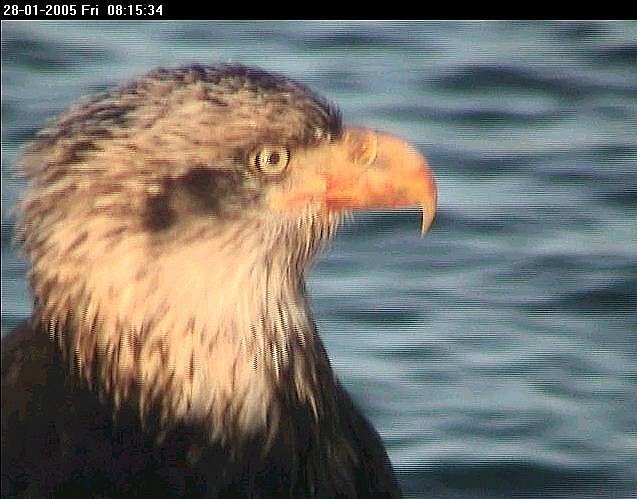 |
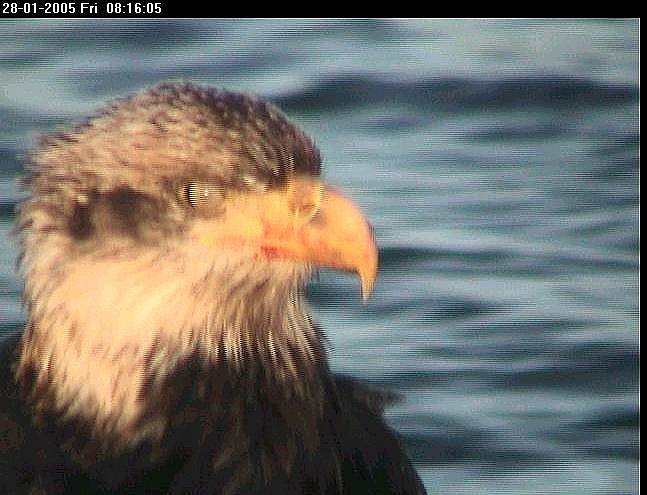 |
Pam captured these images of young eagles close to camera 5 in the spring of 2005 to help us demonstrate this adaptation.You can find further information about this feature at: http://ebiomedia.com/gall/eyes/protect.html |
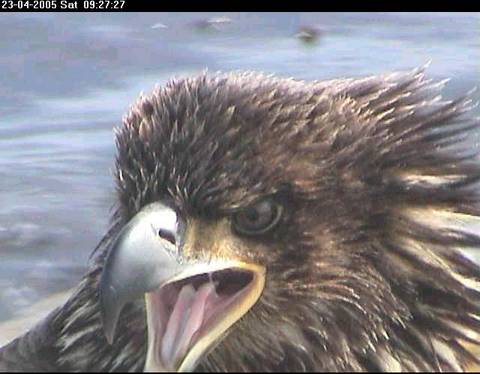 |
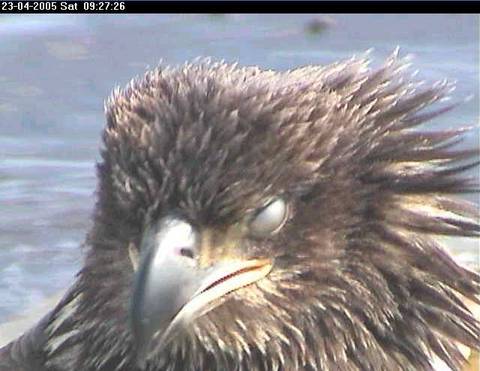 |
Other Members of the Class Aves at Race Rocks.
and Image File |
 The Race Rocks taxonomy is a collaborative venture originally started with the Biology and Environmental Systems students of Lester Pearson College UWC. It now also has contributions added by Faculty, Staff, Volunteers and Observers on the remote control webcams. Carolina Munoz 1987 The Race Rocks taxonomy is a collaborative venture originally started with the Biology and Environmental Systems students of Lester Pearson College UWC. It now also has contributions added by Faculty, Staff, Volunteers and Observers on the remote control webcams. Carolina Munoz 1987 |
Phoca vitulina: Harbour Seal –The Race Rocks Taxonomy
The total harbour seal population in the eastern north Pacific is estimated to be 330,000, and in California the estimated population was 40,000 in 1997. They usually are found in small groups, but sometimes occur in numbers of up to 500.

RANGE/HABITAT: Harbour seals are found across the Northern Hemisphere in both the Atlantic and Pacific Oceans. In the Northeast Pacific, they range from Alaska to Baja California, in Mexico. They favor near-shore coastal waters and frequent sandy beaches, mudflats, bays, and estuaries.
See the most recent posts on harbour seals by the Ecoguardians at Race Rocks
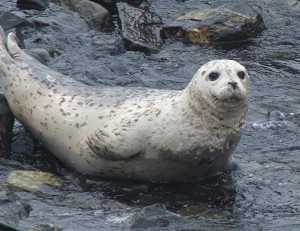 Harbour seals spend about half their time on land and half in water, and they sometimes sleep in water. They can dive to 1,500 feet (457 m) for up to 40 minutes, although their average dive lasts 3 to 7 minutes. They are opportunistic feeders and hunt for sole, flounder, sculpin, hake, cod, herring, octopus, and squid.They will also take fairly large salmon.
Harbour seals spend about half their time on land and half in water, and they sometimes sleep in water. They can dive to 1,500 feet (457 m) for up to 40 minutes, although their average dive lasts 3 to 7 minutes. They are opportunistic feeders and hunt for sole, flounder, sculpin, hake, cod, herring, octopus, and squid.They will also take fairly large salmon.
This image of a mother an baby harbour seal was taken by Ryan Murphy when he was the Ecoguardian at Race Rocks 2009-2011 See this and many more excellent shots on his Flickr album of Race Rocks Seals here.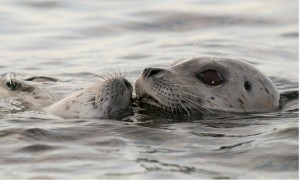
” Ryan and I were doing a live webcast from West Race Rocks, when we came across this harbour seal. It kept returning for a view of our activities so we were able to take several video shots while it hovered nearby. We noticed how it seemed to like returning to this rock pinnacle which was covered with kelp and the plumose anemone. When the lights of the camera get in at close range on the stalks or stipes of the kelp, you can see the brightly colored brooding anemone.” Andras Rozmer, (PC year 26)
Birthing location. Mother and and baby harbour seal. A few scenes taken in June at the time of the harbour seals giving birth. Note membranes still attached to the mother in the swimming scenes near the end.
Harbour seals are year-round residents of Race Rocks. Their numbers increase to over 400 in June and July at the peak of the pupping season. This video shows a quiet scene with seals hauled out on the shore on the west side of Race Rocks.
Domain: Eukarya
Kingdom: Animalia
Phylum: Chordata
Class: Mammalia
Order: Carnivora
Clade: Pinnipedia
Family: Phocidae
Genus : Phoca
Species : vitulina
Phoca vitulina (Linnaeus, 1758 )
COMMON NAME: Harbour Seal
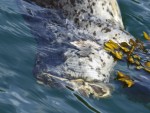 At Race Rocks,the Harbour seals are year round residents, although their numbers peak in mid summer to over 400. They have pups on the island from March to July. This file shows what happens if boat traffic is too fast in the ecological reserve or around any seal haulout area,
At Race Rocks,the Harbour seals are year round residents, although their numbers peak in mid summer to over 400. They have pups on the island from March to July. This file shows what happens if boat traffic is too fast in the ecological reserve or around any seal haulout area,
Damion Wilson PC Year 27.
Other Members of the Class Mammalia at Race Rocks.
See the most recent posts on harbour seals by the Ecoguardians at Race Rocks
and Image File |
 The Race Rocks taxonomy is a collaborative venture originally started with the Biology and Environmental Systems students of Lester Pearson College UWC. It now also has contributions added by Faculty, Staff, Volunteers and Observers on the remote control webcams. The Race Rocks taxonomy is a collaborative venture originally started with the Biology and Environmental Systems students of Lester Pearson College UWC. It now also has contributions added by Faculty, Staff, Volunteers and Observers on the remote control webcams. |
